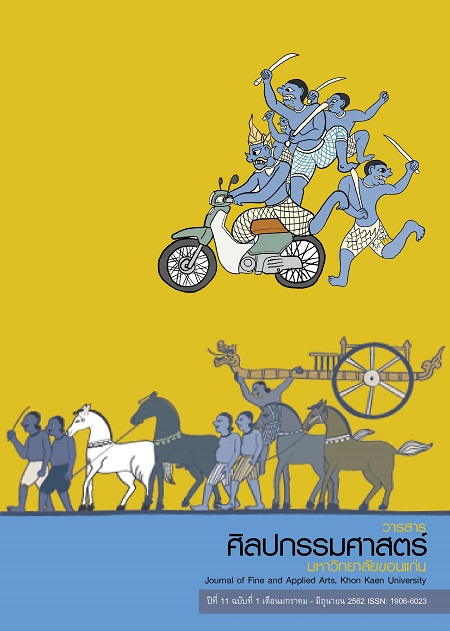Nora Kaek of Pong Pee Nong Troupe in Narathiwat Province
Main Article Content
Abstract
The objectives of the research study entitled “Nora Kaek of Pong Pee Nong Troupe in Narathiwat Province” were to study Nora Kaek of Pong Pee Nong Troupe with reference to its history, elements and method of performance, and to analyze the forms of the performance. The method of research involved reviewing related documents, interviewing the performers, and observations pertaining to the Nora Kaek of Pong Pee Nong Troupe in Narathiwat Province.
The research findings are as follows. The Nora Kaek of Pong Pee Nong Troupe in Narathiwat Province mostly performed in the three southern provinces and it was found that combinations of the performance included the ritual, belief, dance and music all together. The troupe was founded in 1946 by Mr. Juan Junkong and Mrs. Chip Juntem. It was called Nora Kaek of Pong Pee Nong S. Por Nu S. Kwan Kaew, Narathiwat Province. The troupe has its old history going back 71 years, and recently Mr. U-dom Kaewwicean took part as a troup manager or Nai Rong. The performers consisted of Mor Kho Lo (master of the troupe), Por Nora (the troupe headman), young dancers, the Buddhism dancers, the Muslim dancers, Nai Pran (a hunter), and musicians. There were a total of 11 troupe members. The languages used in the show were the southern Thai dialect switching with the local Malay (Melayu) language and sometimes Jeh Hey’ language (the local language used among Buddhists in the three southern provinces of Thailand) has been used in the performance. The band included Klong TuK, Tab, Mong, Cing, Thon, Sue Rue Bab, Pee Su Na, and Tae Rah. The props consisted of Mad Wai, Meet Krok, Pra Kan, and Nah Nai Pran. The popular stories were Pra Ya Prommathad and the occasions of the performances were Kao Sunat Ceremony, Bu Cha Tung Ceremony, and Nora Rong Kru yearly Ceremony. There were four postural dancing styles of the troupe: 1. Sitting (Kue Ngor Ba Ngung); 2. Standing (Ta Ree Ra Kam); 3. Courting (Ta Ree Nae) and 4. The conversation with a hunter. Nowadays, there are three forms of Nora Kaek: 1. The performance for rituals; 2. The performance as a form of folk entertainment; 3. The performance for demonstration. As for the style of the performance, there were four main features: 1. The first show-time depend on the prediction of the troupe headman; 2. The second round of the show will only be at night time; 3. There is no screen or partition on the stage. Performers will dress up on the center of the stage; 4. The Nora theatre has no seats or chairs offered; 5. Palai (A pray station) will be separated in to two parts. Therefore, the researcher found that there was a significant combination of the southern Nora performance and the Mayong performance in Pattani province. However, the performance developed and improved to serve the community’s need and to forge and fostere social relation.
Article Details
Content and information in articles published in the Journal of Fine and Applied Arts of Khon Kaen University is regarded as the opinion and sole responsibility of the author(s) directly; therefore, editors are not obliged to agree to or share any responsibility with regard to the content and information that appears within these articles.
All articles, information, content, image, etc. that have been published in the Journal of Fine and Applied Arts of Khon Kaen University is the copyright of the Journal of Fine and Appllied Arts of Khon Kaen University. Any person or organization who wishes to distribute all or parts of the articles for further dissemination or other usage must first receive permission from the Journal of Fine and Applied Arts of Khon Kaen University before proceeding to do so.
References
บุษกร บิณฑสันต์. (2554). ดนตรีภาคใต้: การถ่ายทอดความรู้ พิธีกรรม และความเชื่อ. กรุงเทพฯ: สำนักพิมพ์แห่งจุฬาลงกรณ์มหาวิทยาลัย.
พรศักดิ์ พรหมแก้ว. (2540). ทีทรรศวัฒนธรรม. กรุงเทพฯ : สถาบันทักษิณคดีศึกษา มหาวิทยาลัย ทักษิณ.
สุธิวงศ์ พงศ์ไพบูลย์. (2542). “โนรา” ในสารานุกรมวัฒนธรรมไทยภาคใต้ เล่ม 8 หน้า 3871 – 3896 มูลนิธิสารานุกรมวัฒนธรรมไทย. นนทบุรี: อมรินทร์ พริ้นติ้งแอนด์พับลิชชิ่ง.


